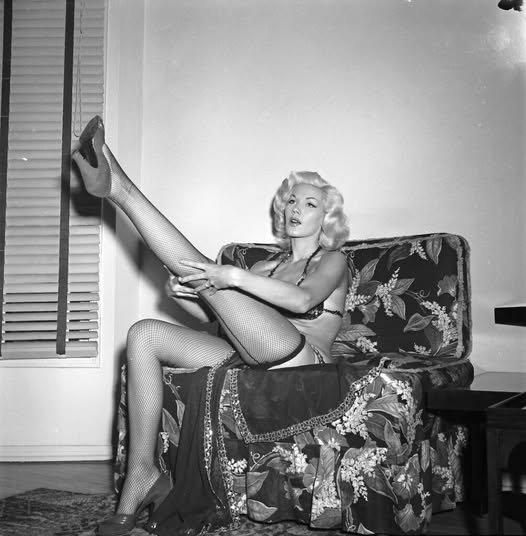
Misty Ayers rose to prominence in the early 1950s as one of the standout figures of the American burlesque revival—a period that bridged traditional vaudeville, the rise of pin-up culture, and a shifting entertainment industry increasingly shaped by film and photography. Though much of her personal background remains a mystery—her birthplace, early life, and even her real name are not widely documented—Ayers nevertheless left an indelible mark on mid-century performance art through her powerful stage presence and dynamic on-screen charisma.
Her career gained traction in a post-World War II America where cultural norms were tightening, even as public curiosity for sensual performance was on the rise. Ayers emerged as a prominent figure in nightclubs and burlesque venues, earning attention for her confident performances and striking physical appearance. While she may not have reached the same mainstream celebrity as some of her contemporaries, her influence on the burlesque scene and her cinematic footprint carved out a lasting niche in entertainment history.
Misty Ayers’s initial fame came from her appearances in burlesque venues and pin-up style photo shoots that were often featured in pulp magazines and local publications. These magazines celebrated a kind of beauty and glamour that wasn’t quite acceptable in high society but was revered by large, loyal audiences. According to Pulp International, Ayers was “pretty well known in her day,” frequently gracing the pages of risqué magazines and promotional materials for live shows.

One of her most iconic early performances was in the 1953 documentary-style film A Night in Hollywood, a feature that showcased various burlesque performers in their element. Ayers shared the screen with stars like Tempest Storm, and while she wasn’t the headliner, her performance stood out for its poise and magnetic energy. The film captures her in her prime, exuding both confidence and sensuality without crossing the lines of mid-century censorship—no easy feat in that cultural climate.
Following her breakout in A Night in Hollywood, Ayers expanded her career into short films and low-budget features that blurred the line between stage spectacle and cinema. In Tijuana After Midnite (1954) and Striptease Goddess (1954), she played herself, performing routines that echoed her live burlesque work. These appearances helped solidify her image as both a dancer and a performer with cinematic appeal.
In 1965, she returned to the screen in a more traditional acting role in Bad Girls Do Cry, where she portrayed the character “Sally Downs.” This transition marked a notable shift from performing as herself in documentary-style shorts to portraying fictional characters, showcasing her adaptability and determination to grow within the entertainment industry.
These films, while not considered mainstream blockbusters, formed the backbone of an alternative film culture that catered to adult audiences in the pre-pornography era. Ayers was part of a generation of women who carved out space in this emerging genre, navigating the fine line between suggestive entertainment and outright scandal.
During the conservative 1950s, female performers were expected to toe a narrow line between allure and acceptability. Burlesque, with its inherent playfulness and erotic undertones, was often under scrutiny. Ayers thrived in this environment, projecting what one publication described as “sexual courage” without abandoning elegance or artistry. Her performances were suggestive without being explicit, embodying a level of control and finesse that reflected both professionalism and personal agency.
Her routines, described by enthusiasts and historians as fluid, expressive, and technically polished, elevated her above mere novelty. Ayers didn’t just dance; she told stories through movement, costume, and timing. Online discussions, even decades later, praise her authenticity, noting how her natural beauty and grounded performances differ from today’s often heavily stylized portrayals of female sensuality.
Although Misty Ayers never became a household name in the way that mainstream film stars did, she occupies a respected place in the annals of burlesque history. Her contributions to mid-century cinema and stage are preserved in specialized archives, film databases, and blogs dedicated to burlesque and vintage Hollywood. Titles like A Night in Hollywood and Striptease Goddess remain touchstones for fans and researchers studying the era.
Her 1965 appearance in Bad Girls Do Cry also speaks to her staying power. More than a decade after her initial rise, she was still being cast and credited—no small feat in an industry known for discarding its performers when trends shift. Whether she was brought in for her vintage appeal or her proven skills, Ayers demonstrated that she had more to offer than just good looks.
Today, Misty Ayers is recognized more as a cult figure than a mainstream celebrity. She represents a lost era of performance that emphasized tease over explicitness, presence over production, and charm over shock value. Her legacy is found in grainy film stills, vintage posters, and in the admiration of modern burlesque artists who cite her and her peers as inspiration.

While little is known about her personal life—no detailed records of family, education, or relationships exist—what remains is the work. Through her performances and screen appearances, Ayers left behind a visual and cultural footprint that continues to captivate scholars, fans, and vintage film collectors.
Misty Ayers’s career may have unfolded largely outside the Hollywood spotlight, but her story is emblematic of countless women in entertainment who made their mark despite limited opportunities and tight societal constraints. From sultry stage routines to low-budget film roles, she built a body of work that continues to echo through burlesque retrospectives and underground cinema history.
Her ability to command a stage, capture a camera’s lens, and evolve with her era reveals a performer who understood not just the art of entertainment, but also the power of presence. Misty Ayers wasn’t just a burlesque dancer—she was a symbol of resilience, reinvention, and unapologetic performance artistry.




